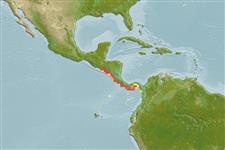Actinopterygii (ray-finned fishes) >
Perciformes (Perch-likes) >
Lutjanidae (Snappers) > Lutjaninae
Etymology: Lutjanus: Malay, ikan lutjan, name of a fish. More on author: Jordan, Gilbert.
Environment / Climate / Range
Ecology
Marine; brackish; reef-associated; depth range 1 - 70 m (Ref. 9313). Subtropical, preferred ?; 36°N - 4°N, 90°W - 77°W (Ref. 55)
Eastern Pacific: southern California, USA to Panama; rare north of Baja California, Mexico. There are unsubstantiated reports of this species from localities as far south as northern Peru.
Size / Weight / Age
Maturity: Lm ? range ? - ? cm
Max length : 91.0 cm TL male/unsexed; (Ref. 2850); max. published weight: 9.3 kg (Ref. 40637)
Adults inhabit inshore reef areas over hard bottoms. Generally solitary (Ref. 9313). Juveniles are sometimes encountered in shallow coastal waters and estuaries (Ref. 9313). Carnivorous, feed on invertebrates and fishes (Ref. 9313). Marketed fresh or frozen (Ref. 9313).
Life cycle and mating behavior
Maturity | Reproduction | Spawning | Eggs | Fecundity | Larvae
Allen, G.R., 1985. FAO Species Catalogue. Vol. 6. Snappers of the world. An annotated and illustrated catalogue of lutjanid species known to date. FAO Fish. Synop. 125(6):208 p. Rome: FAO. (Ref. 55)
IUCN Red List Status (Ref. 115185)
CITES (Ref. 94142)
Not Evaluated
Threat to humans
Harmless
Human uses
Fisheries: commercial
More information
Common namesSynonymsMetabolismPredatorsEcotoxicologyReproductionMaturitySpawningFecundityEggsEgg development
ReferencesAquacultureAquaculture profileStrainsGeneticsAllele frequenciesHeritabilityDiseasesProcessingMass conversion
Tools
Special reports
Download XML
Internet sources
Estimates of some properties based on models
Phylogenetic diversity index (Ref.
82805): PD
50 = 0.5000 [Uniqueness, from 0.5 = low to 2.0 = high].
Bayesian length-weight: a=0.01202 (0.00706 - 0.02048), b=2.96 (2.82 - 3.10), in cm Total Length, based on LWR estimates for this species & Genus-body shape (Ref.
93245).
Trophic Level (Ref.
69278): 3.1 ±0.0 se; Based on diet studies.
Resilience (Ref.
69278): Low, minimum population doubling time 4.5 - 14 years (Preliminary K or Fecundity.).
Vulnerability (Ref.
59153): Moderate to high vulnerability (54 of 100) .
